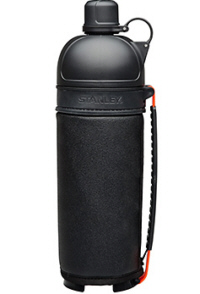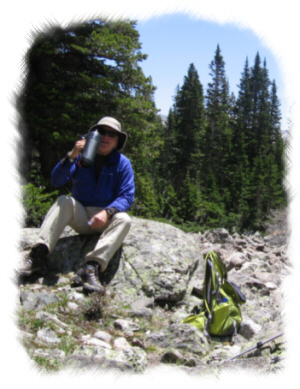|
STANLEY NINETEEN13
CARBONATED DRINK BOTTLE
BY KATHLEEN WATERS
JULY 18, 2012

OWNER REVIEW
TESTER INFORMATION
|
NAME:
|
Kathleen Waters
|
|
EMAIL:
|
kathy at backpackgeartest dot com
|
|
AGE:
|
61
|
|
LOCATION:
|
Canon City, Colorado, USA
|
|
GENDER:
|
F
|
|
HEIGHT:
|
5' 4" (1.60 m)
|
|
WEIGHT:
|
125 lb (56.70 kg)
|
Living in Colorado and being self-employed, I have ample opportunities to backpack. There are over 700,000 acres/280,000 hectares of public land bordering my 71-acre/29-hectare "backyard" in addition to all the other gorgeous locations which abound in Colorado.
Over the past 15 years, my husband John and I have also had the good fortune to hike/snowshoe glaciers, rain forests, mountains and deserts in exotic locations, including New Zealand, Iceland, Costa Rica, Slovenia and Death Valley.
My hiking style is comfortable, aiming for lightweight. I use a tent (rainfly if needed). Current pack averages 25 lb (11 kg) excluding food and water.
PRODUCT INFORMATION
Manufacturer: Stanley, brand of Pacific Market International (PMI)
Year of Manufacture: 2011
Manufacturer's Website: http://www.stanley-pmi.com/
MSRP: US $28.00
Listed Weight: N/A
Measured Weight: 13.5 oz (383 g)
Listed Capacity: 32 fl oz (1 L) - verified as accurate
Colors Available: Black, Camo & Stormtrooper
Color Reviewed: Black
Lifetime Warranty |  | | Photo Courtesy of Stanley-PMI |
|
PRODUCT DESCRIPTIOIN
The Stanley Nineteen13 Carbonated Drink Bottle is one of Stanley's insulated bottle products with a twist. As the name implies, this bottle was designed specifically for carbonated beverages such as soda, beer and sparkling wine. Stanley lists this bottle under "Spirits" on their website.
Mine is the black model which stands 12.5 inches (32 cm) tall from base to the top of the bottle-cap spout. The base is a hard material with an "indented" center so the bottle appears to be standing on three edges. There is a 7-inch (18 cm) high insulated outer wrap that feels spongy and wraps around the 11.5-inch (29 cm) circumference of the bottle.
Along the side of the bottle is a slightly over 1-inch (2.5 cm) rubber-like holding/carrying strap which is 8.5 inches (22 cm) long. This strap connects to the bottle at both ends with a bright orange hard plastic-like section which wraps around a metal connecting pin. While the outer side of this strap is smooth, the interior is ridged.
Just above the insulated outer wrap is the connection for the twist-off lid. Removing the lid reveals a 3-inch (7.6 cm) fill opening. This lid is capped with another twist-off cap similar to a common 2 L bottled water (or soda) container. This cap is attached to the fill-lid via a flexible short strap and two metal connecting pins. The drink opening is just about 0.75 inches (2 cm) wide.
FIELD USE AND PERFORMANCE
 | | Cold Beer at Lunch on the Trail in Breckenridge |
| Locations and Weather Conditions
Over the last 11 months, the Stanley Nineteen13 Carbonated Drink Bottle (hereafter called simply, "the bottle"), has accompanied me on at least a half dozen day-hikes and one 2-night overnight trip.
Outside of the state of Colorado, I packed the bottle on a 2011 mid-September trip to Yellowstone and Grand Teton National Parks in Wyoming and a two-day backpack in Dinosaur National Monument, in Utah.
In-state, but out of my immediate area, the bottle was used on a day-hike snowshoe in Rocky Mountain National Park in December 2011. Also, John and I spent the last week of May in Breckenridge, exploring the Ten-Mile Range. Three day-hikes included the White Falls Trail, the Quandary Peak Trail from 10,979 to 13.424 ft (3346 to 4092 m), and the 11.481 ft (3499 m) Boreas Pass trail which climbs to a saddle 12159 ft (3706 m) and separates Bald and Boreas Mountains from Hoosier Ridge. Despite the higher start elevations (all over 10.000 ft/3000 m); the temperatures were mild, from 40 to 69 F (4 to 21 C). It was very windy though on Quandary Peak - so windy we turned back before summiting.
However, most of my day hikes and subsequent use of the bottle were while exploring the Bureau of Land Management wilderness that abuts our northern property line. There are thousands of acres/hectares of the Rocky Mountains between us and Pike's Peak in Colorado Springs. This land ranges in elevation from 5400 ft (1600 km) to 14,000 ft (4300 km) at Pikes Peak. I'd say that average elevation for most hikes was around 6000 ft (1800 km). |
Performance
On more than one occasion at the end of a long day's hike or a summit to a gorgeous view, I've wished for a celebratory adult beverage. How neat it would be to toast the event with a sip (or two) of sparkling wine or complement that bowl of chili with a frosty beer. Alas, even if I had a fool-proof way of keeping either even remotely cold, I certainly wasn't about to carry glass bottles uphill - or even down hill. The fear of breaking glass on a stumble and the thought of packing intact glass back out, definitely ruled the bubbly stuff out. Or so I thought.
Enter the Stanley Nineteen13 Carbonated Drink Bottle! When I saw the Stanley, I was excited and knew, if it worked, I had to have one!
I was immediately unsure of the relative bulk of the bottle though. The empty Stanley bottle weighs just about the same as an empty wine bottle and is slightly bigger by height (12.5 in/32 cm vs. 12 in/ cm)) and circumference (11.5 in/29 cm vs. 9.5 in/ cm). But those (larger) Stanley measurements include the insulation that keeps beverages cold, so the slightly larger volume needed in my pack would be well worth it, I reasoned. And there wouldn't be any glass to worry about.
On the first opportunity to try out the bottle, I grabbed two icy cold beer bottles from the refrigerator and carefully, using my bartending skills from a previous life, poured the beer down the inside of the Stanley so as to not create a lot of foam/head which would release any more carbonation than was necessary. Then I quickly put the top back on the bottle and tightly twisted it closed.
I knew there was no way the bottle was going to fit in my backpack. It was crammed full and unfortunately, the side pouches of my Black Diamond 65L Onyx backpack where I would usually stash a water bottle or two are just too small - actually, none of my backpacks has side pockets large enough for the bottle. So, John was the official beer-toter. He has a ULA pack with a large exterior pouch into which the bottle fit nicely. He didn't complain about the extra weight 'cause hey, a brew was involved.
After 4 hours of trekking up a ridge in the Cooper Mountain range in Fremont County, we stopped to take a lunch break and decided to sample the brew. I was a bit nervous about opening the cap as between the bouncing of the bottle, the carbonation and the altitude; the possibility of a beer shower was an unpleasant thought. No need for the worry though - there was a slight "hiss" as some of the bubbles escaped when the cap was slowly twisted off, but no liquid or foam.
The beer was cool, but not cold. Way better than British serving temperature, but certainly not as cold as I would have liked. However, it was just as certainly welcome with our pepperoni and mozzarella cheese sandwiches. Yummy!
We deliberately did not finish the whole bottle but saved a bit to see how the rest would fare over the next couple of hours. It didn't. By the time we stopped for the day (maybe 2 hours later), the carbonation had totally dissipated and the beer was warm. Bleck!
After a couple more trials on the trail, we've learned to drink all the contents of the bottle at once or the empty headroom of the bottle allows the gas to escape and the liquid goes flat. Also in temperatures above 100 F (38 C) as we have been having a lot of here in Canon City area, cold liquid doesn't stay that way for more than 3-4 hours or so.
I've had similar results with carbonated water and sodas as well.
Onto sparkling wine! My main intent for the Stanley was for sparkling wine celebrations after a summit. I always imagined summiting a Colorado Fourteener (term for peaks over 14,000 ft/4,000 m), pouring some bubbly and clinking glasses - all right, titanium cups - with John. I'm still imagining that after several unsuccessful attempts but we optimistically packed along the bottle on our last foray up the Quandary Peak trail. Thanks to nasty winds, we turned around about 800 ft (244 m) from the summit. Gee, now what do we do with the sparkling wine? ;) Why, drink it, of course!
The wine was delicious - a nice Barefoot Moscato Spumante - not ice cold, but cold enough and bubbly enough too. We thoroughly enjoyed it while plotting our next Quandary attempt in the coming fall.
After almost a year, the bottle looks like new. I've known Stanley products to be extremely durable through my childhood experiences which include dropping my dad's Stanley thermos on more than one occasion, so the fact that this bottle shows no adverse signs of use is not surprising to me.
Thanks to the bottle's very wide opening once the top is removed, it is very easy to clean. I have found strong flavors like John's favorite cherry carbonated vitamin water tend to be harder to eradicate. A quick swish of clear water doesn't do the trick, but a thorough scrubbing with soapy water does.
After only one backpack, John and I mutually decided that we really didn't need to have carbonated beverages - soda, beer, sparkling wine or any thing else with bubbles. The bottle is just too big - not that much more than a wine bottle would be but then again, carrying a wine bottle was never a consideration. Neither one of us cares to leave behind whatever we would have to so the bottle would fit in our packs. I tried just using a carabineer to attach the bottle to the outside of my pack but couldn't bear the swinging back and forth action of the bottle - not to mention that swinging caused the carbonation to dissipate even more quickly. So, for us, the bottle has been relegated to the "day-hike" shelf in our gear closet.
STARRING ATTRACTIONS
1.) Keeps drinks reasonably cold up to 4-5 hours
2.) Can stand up to abuse on the trail.
3.) Cleans up effortlessly
MINOR DISTRACTIONS
1.) For me, it's really too bulky for backpacking trips.
2.) Unless it is full, fizz is not maintained that well.
SUMMARY
I think the Stanley carbonated drink bottle is a wonderful idea for casual use, picnics, base camping, car camping and even day-hikes - if the intended distance isn't very long, the terrain very rough and/or pack-weight is not a concern. Having the ability to carry really cold bubbly soft or adult beverages into the great outdoors is a bonus luxury, especially if honoring a special location or occasion.
The carbonated drink bottle does exactly what I have come to expect from a Stanley product. It delivers cold liquid when I want it, where I want it, is rugged and a great value.
While I won't be carrying this bottle on a weeklong backpacking trip while toting a full 30 lb (14 kg) backpack, I will tuck it into a daypack for a celebratory drink on the summit of a Colorado Fourteener!
Kathleen (Kathy) Waters
This report was created with the BackpackGearTest.org Report Writer Version 1.5
Copyright 2012. All rights reserved.
Read more reviews of Stanley PMI gear
Read more gear reviews by Kathleen Waters
|




